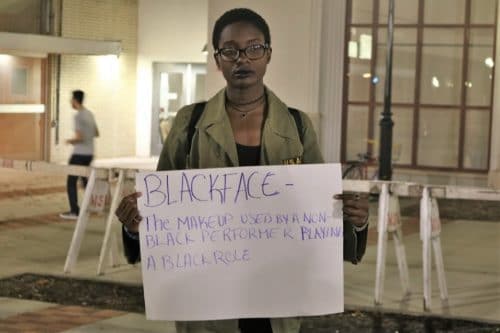The opening of “Aida” seems to have unleashed a massive amount of controversy on Montclair State’s campus, with students lined up with signs and megaphones to protest what they saw as blackface. Now, it appears that everyone on campus—whether involved in the production or not—has an opinion on the matter.
“Blackface” is defined by the Oxford English Dictionary as “makeup worn by a white actor playing a black person.” Supporters of the production’s makeup claim that the goal of the makeup is only to tan the actors, as the characters they portray are in the sunlight for most their lives, and therefore its application is not blackface.
Since several of the actors portray Egyptian characters, objectors claim that the use of bronzer is racially insensitive. They believe this tanning procedure is, in fact, blackface—even if it is not as obvious as the kind used in minstrel shows of the late nineteenth century, when the term became popularized.
If this was the only evidence both for and against the accusation of blackface in the show, the conversation would be short-lived. However, there is in fact a much larger context surrounding the claim that blackface is being used in the show.
In the traditional casting of Aida, the Egyptian characters were played by white actors and the Nubian ones were played by black actors. Supporters of the show’s makeup decisions claim that, because of this, the tanning of white actors isn’t blackface—after all, these actors are always meant to be white, aren’t they?
However, this argument falls apart when looking more closely at the actual casting decisions. Aida is traditionally cast with a racially split cast to compare the Egyptian/Nubian struggle to current racial struggles in America. In this case, the actors are meant to represent white and black Americans, as opposed to actual Egyptians and Nubians, and thus there is no need for the actors to appear as if they have been working out in the sun all their lives.
In addition, if realism was really a concern for the creative crew, despite the show being one big metaphor, then there would be no white actors in the show, because at the time, Egypt and Nubia were inhabited solely by people of color. The realization that characters who are outside all day would have their skin darkened by the sun, without the realization that all Egyptians in the area the musical takes place would have naturally dark skin even before tanning, is ultimately what protesters have taken issue with.
The original concerns raised by a person of color were thrown out the window, according to the student who sparked protests, and now many individuals have attempted to explain how the use of this makeup is not blackface.
Even if it was definitively argued that this makeup wasn’t blackface, white individuals cannot be the ones who claim this is not a problem, as only people of color can determine what is or is not racially insensitive. At the end of the day, when black students are discussing racial injustice, it is not a white student’s place to step in and claim to be the be-all, end-all on the subject.
The takeaway of this incident is that Montclair State University is an extremely diverse school and that we need to do better for ourselves. It can be hard, because of our reputation as a diverse institution, to accept responsibility when we have wronged—but because of our reputation, we must admit when we have wronged. It is the only way for us to grow as an institution.
Until Montclair’s theatre department takes responsibility for this lapse of judgment, students will remain skeptical of their racial sensitivity. For now, students will look to the department to see what their next move is—especially as they get ready for their production of West Side Story, whose characters are entirely of Latin American descent, in the spring semester.



